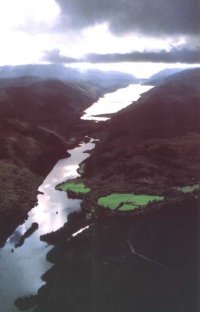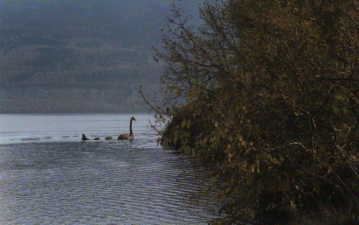

Nearly 1000 feet deep and 24 miles long, Scotland's Loch Ness is believed by many to be home to the unidentified aquatic creature affectionately dubbed "Nessie." She is arguably the best known cryptozoological creature in the world. No other monster is as tied in with a country's image as Nessie is with Scotland. Nessie is certainly one of the most-sighted monsters in the world.
There are many negatives in the search for lake monsters. Despite many credible eyewitness sightings, no live monsters have been caught after innumerable attempts in their respective lakes. No carcasses have ever been found that might be anything other than recognizable animals. It is a fact that giant nets, submarines, underwater cameras, sonar, and loch-side crews of observers have all failed to come up with the solid evidence that will prove to the world that there is a Loch Ness Monster.
On the other hand, the great number of eyewitness sightings--which show no signs of abating--make it hard to easily dismiss Nessie, who remains the Queen of all lake monsters.

Most of the Nessie witnesses describe something with two humps, a tail, and a snakelike head. A V-shaped wash was also often mentioned, and such details as a "gaping red mouth" and horns or antennae on the top of the creature's head were sometimes noted. Nessie's movements have been studied, and the films and photos analyzed to determine what Nessie might be, if she exists.
There are numerous theories as to Nessie's identity, including a snake-like primitive whale known as a zeuglodon, a type of long-necked aquatic seal, giant eels, walruses, floating mats of plants, giant molluscs, otters, a "paraphysical" entity, mirages, and diving birds, but many lake monster researchers seem to favor the plesiosaur theory. Most scientists believe that these marine reptiles have been extinct for 60-70 million years, but others think it possible that after the last Ice Age the Loch may have been connected to the sea, and some of these dinosaurs may have been stranded. Others, like David Hall, feel that lake monsters could not possibly be plesiosaurs since plesiosaurs were cold-blooded reptiles that would have preferred warm oceanic currents to cold Scottish Lochs.

And we cannot afford to ignore the fact that sometimes Nessie is a hoax. Only one thing is certain about Nessie: that there are as many theories about her identity as there are theorists.

On August 8th a crew made up of Loch Ness Investigation Bureau and Academy members were operating this equipment from vessels in Urquhart Bay. In the early hours of that morning their Raytheon sonar detected in its sound beam the presence of large moving objects from which shoals of fish were taking evasive action. It tracked one object as it passed about 20ft from the underwater camera, which was at a depth of 45ft and was set to flash every 15 seconds. The picture obtained, although indistinct due to the murkiness of the water, show the offside hind quarter, flipper and part of the tail of a large animal with a rough textured skin of a greeny-brown colour. Experts estimated the flipper to be from 6 to 8 ft in length. American Smithsonian Institution, one of several top bodies approached for comment stated that the tail structure resembled the shape of the tail of newts. The New England Aquarium stated that the flipper-like structure certainly did not appear to resemble the structure of any known mammilian creature. The British Natural History Museum, while acknowledging that the photograph were genuine found that 'the sequence appears to show the passage of a large object'. The sonar chart which recorded the passage of the objects was subsequently analysed by several independent experts, whose composite verdict found that there are large animals in Loch Ness which are at least 20 to 30ft long with 'several segments, body sections or projections such as humps'.

For the next few years there team had very little success which had a lot to do with malfunctions in the underwater camera rigs. In 1975 the biggest breakthrough for Dr. Rines and his team came when a set of close-up underwater photographs were taken which when released in December of that year caused a worldwide sensation. The pictures which show the head and body of one of the creatures in remarkable detail, were taken with the Edgerton strobe camera during the expedition the previous June. For several months the pictures were examined in secret in zoological centres in Britain, America, Canada and Europe.
It was planned to release them in early December at a scientific symposium in Edinburgh to be attended by zoologists from all over the world under the chairmanship of the famous British naturalist and painter Sir Peter Scott. News of the pictures leaked out at the end of November, before the study of them was complete and caused such excitement that the sponsors of the symposium, who included the prestigious Royal Society, felt it would be impossible to conduct a proper scientific discussion in such an atmosphere. Consequently the symposium, at which the whole Loch Ness controversy would have been debated at length and hopefully resolved, had to be cancelled. In its place a meeting was held in the Grand Committee Room at the Houses of Parliament at the instigation of David James, the MP who had led the Investigation Bureau. Before a large audience of members of both houses of Government, scientists and journalists, the Academy team presented the results of their research, including the new underwater photographs, together with supporting statements from eminent zoologists who had been examining the material. Dr. George Zug, the Curator of Reptiles and Amphibians at the renowned Smithsonian Institution in Washington said in his personal statement : "I believe these data indicate the presence of large animals in Loch Ness, but are insufficient to indentify them".